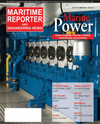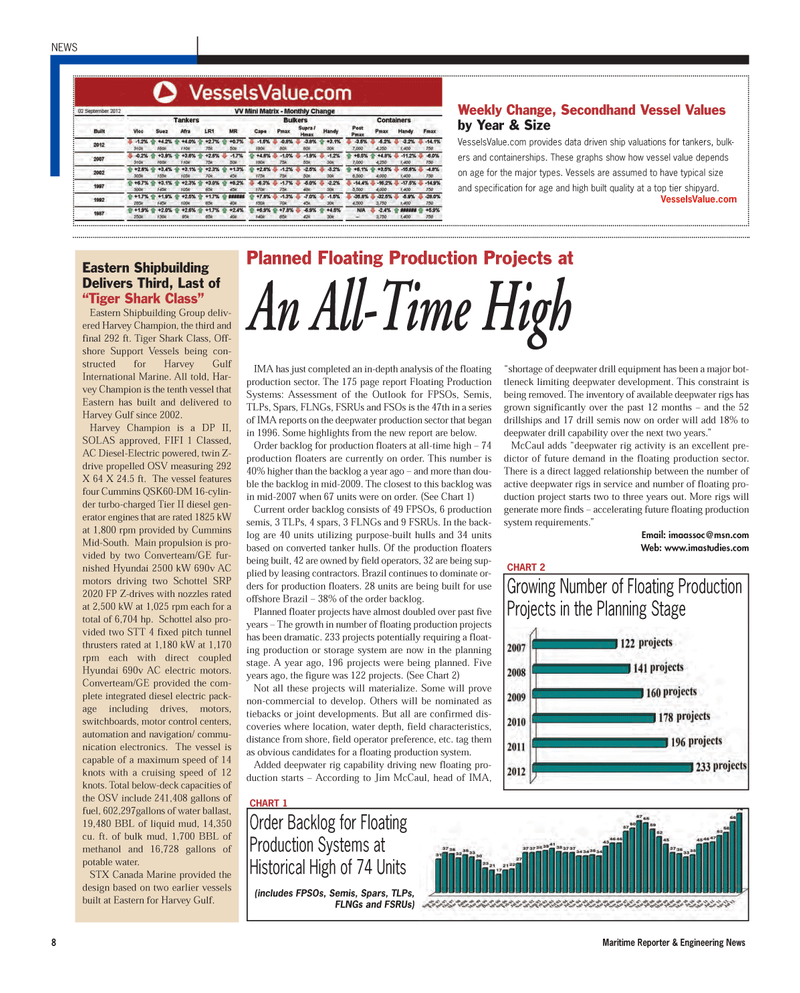
Page 8: of Maritime Reporter Magazine (September 2012)
Marine Propulsion Annual
Read this page in Pdf, Flash or Html5 edition of September 2012 Maritime Reporter Magazine
NEWSWeekly Change, Secondhand Vessel Values by Year & Size VesselsValue.com provides data driven ship valuations for tankers, bulk- ers and containerships. These graphs show how vessel value dependson age for the major types. Vessels are assumed to have typical size and specification for age and high built quality at a top tier shipyard. VesselsValue.com Eastern ShipbuildingDelivers Third, Last of ?Tiger Shark Class? Eastern Shipbuilding Group deliv- ered Harvey Champion, the third and final 292 ft. Tiger Shark Class, Off- shore Support Vessels being con- structed for Harvey Gulf International Marine. All told, Har- vey Champion is the tenth vessel that Eastern has built and delivered to Harvey Gulf since 2002. Harvey Champion is a DP II, SOLAS approved, FIFI 1 Classed, AC Diesel-Electric powered, twin Z- drive propelled OSV measuring 292 X 64 X 24.5 ft. The vessel features four Cummins QSK60-DM 16-cylin- der turbo-charged Tier II diesel gen- erator engines that are rated 1825 kWat 1,800 rpm provided by Cummins Mid-South. Main propulsion is pro-vided by two Converteam/GE fur- nished Hyundai 2500 kW 690v AC motors driving two Schottel SRP 2020 FP Z-drives with nozzles rated at 2,500 kW at 1,025 rpm each for atotal of 6,704 hp. Schottel also pro-vided two STT 4 fixed pitch tunnel thrusters rated at 1,180 kW at 1,170rpm each with direct coupledHyundai 690v AC electric motors. Converteam/GE provided the com- plete integrated diesel electric pack- age including drives, motors, switchboards, motor control centers,automation and navigation/ commu- nication electronics. The vessel is capable of a maximum speed of 14knots with a cruising speed of 12knots. Total below-deck capacities of the OSV include 241,408 gallons of fuel, 602,297gallons of water ballast, 19,480 BBL of liquid mud, 14,350cu. ft. of bulk mud, 1,700 BBL of methanol and 16,728 gallons of potable water. STX Canada Marine provided the design based on two earlier vessels built at Eastern for Harvey Gulf. IMA has just completed an in-depth analysis of the floatingproduction sector. The 175 page report Floating Production Systems: Assessment of the Outlook for FPSOs, Semis, TLPs, Spars, FLNGs, FSRUs and FSOs is the 47th in a series of IMA reports on the deepwater production sector that began in 1996. Some highlights from the new report are below. Order backlog for production floaters at all-time high ? 74production floaters are currently on order. This number is 40% higher than the backlog a year ago ? and more than dou-ble the backlog in mid-2009. The closest to this backlog was in mid-2007 when 67 units were on order. (See Chart 1) Current order backlog consists of 49 FPSOs, 6 productionsemis, 3 TLPs, 4 spars, 3 FLNGs and 9 FSRUs. In the back- log are 40 units utilizing purpose-built hulls and 34 units based on converted tanker hulls. Of the production floaters being built, 42 are owned by field operators, 32 are being sup- plied by leasing contractors. Brazil continues to dominate or- ders for production floaters. 28 units are being built for use offshore Brazil ? 38% of the order backlog. Planned floater projects have almost doubled over past five years ? The growth in number of floating production projects has been dramatic. 233 projects potentially requiring a float-ing production or storage system are now in the planning stage. A year ago, 196 projects were being planned. Five years ago, the figure was 122 projects. (See Chart 2) Not all these projects will materialize. Some will prove non-commercial to develop. Others will be nominated as tiebacks or joint developments. But all are confirmed dis- coveries where location, water depth, field characteristics, distance from shore, field operator preference, etc. tag them as obvious candidates for a floating production system. Added deepwater rig capability driving new floating pro- duction starts ? According to Jim McCaul, head of IMA, ?shortage of deepwater drill equipment has been a major bot- tleneck limiting deepwater development. This constraint is being removed. The inventory of available deepwater rigs has grown significantly over the past 12 months ? and the 52 drillships and 17 drill semis now on order will add 18% to deepwater drill capability over the next two years.? McCaul adds ?deepwater rig activity is an excellent pre- dictor of future demand in the floating production sector. There is a direct lagged relationship between the number ofactive deepwater rigs in service and number of floating pro- duction project starts two to three years out. More rigs will generate more finds ? accelerating future floating production system requirements.? Email: [email protected]: www.imastudies.com Planned Floating Production Projects at An All-Time High CHART 2Growing Number of Floating Production Projects in the Planning Stage CHART 1Order Backlog for Floating Production Systems at Historical High of 74 Units(includes FPSOs, Semis, Spars, TLPs,FLNGs and FSRUs)8Maritime Reporter & Engineering News MR#9 (1-9):MR Template 9/12/2012 9:16 AM Page 8

 7
7

 9
9
